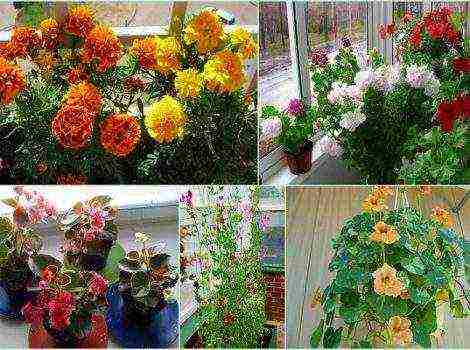Content
- 1 Early ripening blackcurrant varieties
- 2 Medium ripening black currant varieties
- 3 Late ripening varieties
- 4 How to choose currants for planting on the site
- 5 The largest varieties
- 6 The sweetest black currant
- 7 Earliest and latest varieties
- 8 New varieties of black currant
- 9 What currants can be grown in the regions
- 9.1 Black currant for cultivation in the Moscow region
- 9.2 Varieties suitable for the Northwest region
- 9.3 Black currant for growing in the Black Earth Region
- 9.4 Currant varieties for Siberia
- 9.5 Black currant for growing in Belarus
- 9.6 Varieties for cultivation in Ukraine
- 9.7 Black currant variety Katyusha
- 9.8 Black currant variety Pamyat Vavilov
- 9.9 Black currant variety Klussonovskaya
- 9.10 Belarusian black currant variety Ceres
- 9.11 Russian variety of black currant Heiress
- 9.12 Blackcurrant variety Titania
- 9.13 Black currant variety Belorusochka
- 9.14 Ukrainian variety of black currant Sanyuta
- 10 Breeding region and breeding history
- 11 Photo
- 12 Description of the currant variety "Belarusian Sweet"
- 13 Application of berries
- 14 Care
Black currant varieties for cultivation in Belarus: Sorceress, Heiress, Belorusochka, Belorusskaya sweet, Katyusha, Kupalinka, etc.
Cearly ripening black currant
ENCHANTRESS
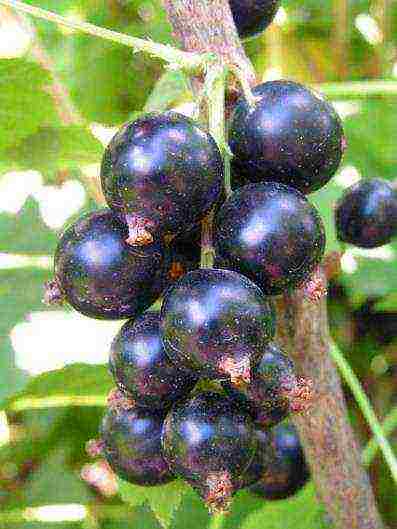
Variety universal purpose.
Bush medium-sized, spreading, medium branching.
Biological features: grade highly self-fertile.
Fruit brush long, medium thickness and density.
Berries large (average weight - 1.6 g), roundish, black, with medium skin, sweet taste... The appearance is attractive. Medium density pulp, sweet-sour taste, pleasant. Tasting taste score is high.
Dignity: The variety is winter-hardy, high-yielding (11 t / ha). Marketability and transportability of fresh berries is high.
Flaw: Relatively resistant to spheroteca, anthracnose and kidney mite.
HEIRESS
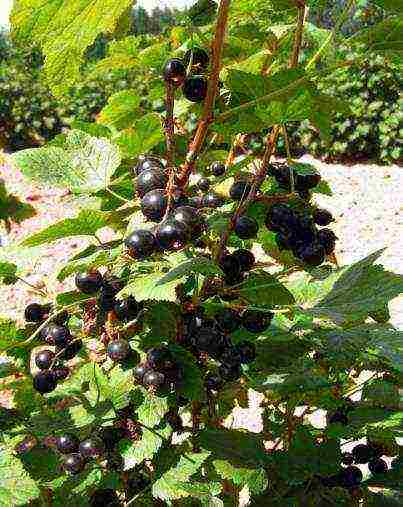
Variety universal purpose.
Bush medium-sized, slightly spreading.
Biological features: grade highly self-fertile.
Fruit brush medium in size, firm.
Berries medium (average weight - 0.9-1.0 g), black, matte, rounded, with a thin but dense skin, dry separation, sweet and sour taste. The appearance is attractive. Tasting assessment of fresh berries - 4.0 points.
Dignity: The variety is winter-hardy, productive (9 t / ha). The transportability of fresh berries is good. Mildly affected by American powdery mildew
Flaw: Moderately affected by leaf spots
Cmedium-ripening blackcurrant orta
Viola
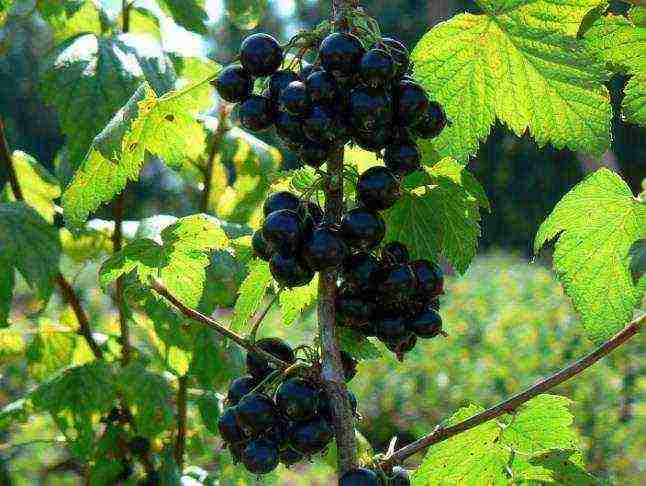
Variety universal purpose.
Bush medium-sized, semi-spreading, medium branching.
Biological features: grade highly self-fertile.
Fruit brush medium in size, firm.
Berries large (average weight - 1.4 g), round, black. The appearance is attractive. Medium density pulp, sweet and sour taste. Tasting assessment of fresh berries - 4.0 points.
Dignity: The variety is winter-hardy, productive (up to 7 t / ha).
Flaw: The variety is relatively resistant to spheroteca, strongly affected by leaf spots. Relatively resistant to kidney mites.
Belorusochka
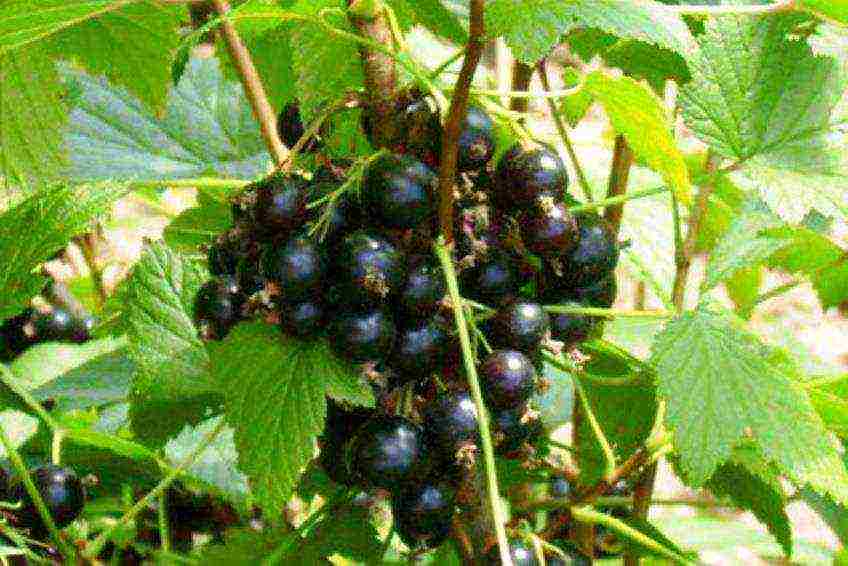
Variety universal purpose.
Bush vigorous, slightly spreading.
Biological features: highly self-fertile.
Fruit brush long, medium thickness and density.
Berries large (average weight - 1.4 g). The taste is sour-sweet, pleasant, the pulp is juicy. Tasting score - 4.5 points.
Dignity: The variety is winter-hardy, fruitful, there is no shedding of berries. The transportability of fresh berries is high. Suitable for mechanized harvesting.
Flaw: Moderately affected by American powdery mildew and leaf spots.
BELARUSIAN SWEET
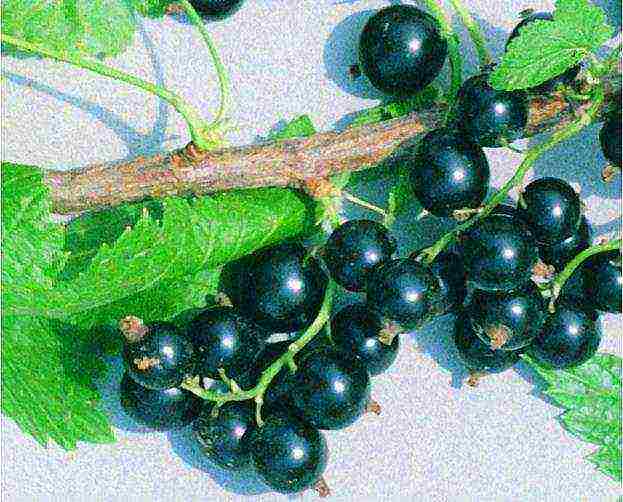
Variety universal purpose.
Bush vigorous, large, slightly spreading, medium branching.
Biological features: the variety is highly self-fertile. Additional pollinators - Pilot Alexander Mamkin, Minai Shmyrev.
Fruit brush long and medium.
Berries large (average weight - 1.2 g). The aroma of the berries is medium. The pulp is juicy, the taste is sweet. Tasting taste score is good.
Dignity: The variety is winter-hardy, productive (12 t / ha). The transportability of fresh berries is high. Sprinkling of berries is absent. Suitable for mechanized harvesting.
Flaw: Medium resistant to spheroteca and relatively resistant to kidney mites.
Vernissage
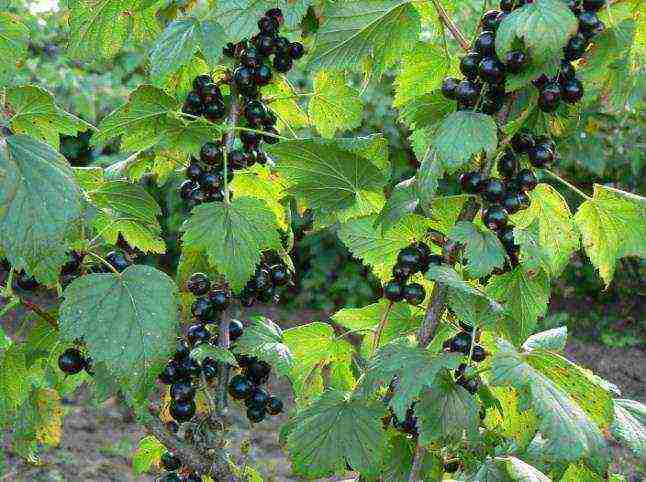
Variety universal purpose.
Bush medium-sized, semi-spreading, medium branching.
Biological features: the variety is highly self-fertile.
Fruit brush average.
Berries medium (average weight - 1.3 g), round, black. The appearance is attractive. Tasting assessment of fresh berries - 4.0 points. Medium density pulp, sweet and sour taste.
Dignity: The variety is winter-hardy, high-yielding (up to 8.0 t / ha). Resistant to anthracnose, slightly affected by septoria. Sprinkling of berries is absent.
Flaw: Relatively resistant to spheroteca and kidney mites.
Pigeon
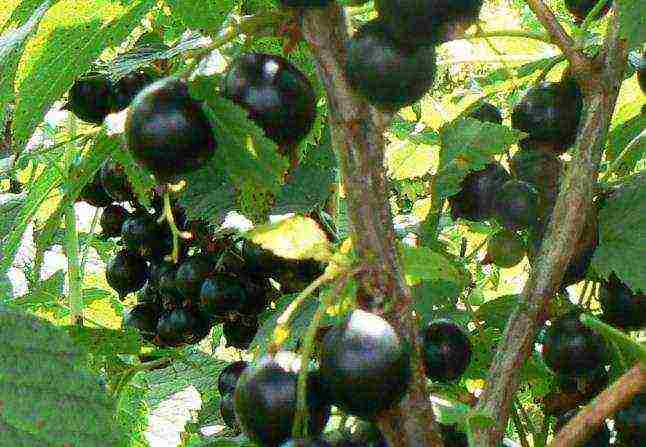
Variety universal purpose.
Bush medium-sized, erect, medium branching.
Biological features: the variety is highly self-fertile.
Fruit brush medium or long.
Berries medium (average weight - 1.3 g), round, black, matte with a blue waxy coating. The appearance is attractive. Tasting assessment of fresh berries - 4.0 points. Medium density pulp, sweet and sour taste.
Dignity: The variety is winter-hardy, high-yielding (up to 7.0 t / ha).
Flaw: Relatively resistant to spheroteca and kidney mites, strongly affected by leaf spots.
Mystery
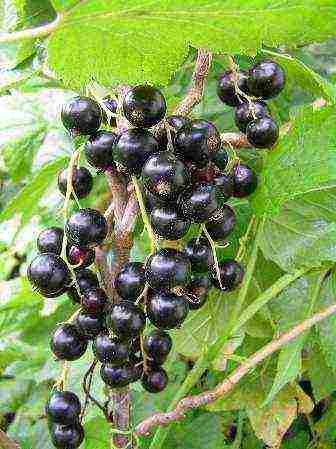
Variety universal purpose.
Bush medium-sized, straight, slightly spreading, average branching.
Biological features: the variety is highly self-fertile.
Fruit brush long and medium.
Berries large (average weight - 1.1 g), round, black, with a dense skin. The appearance is attractive. Tasting assessment of fresh berries - 4.0 points. Medium density pulp, sweet-sour taste, pleasant.
Dignity: The variety is winter-hardy, high-yielding (up to 8.5 t / ha). Slightly affected by spheroteca, moderately affected by leaf spots.
Flaw: Relatively resistant to kidney mites.
KATYUSHA
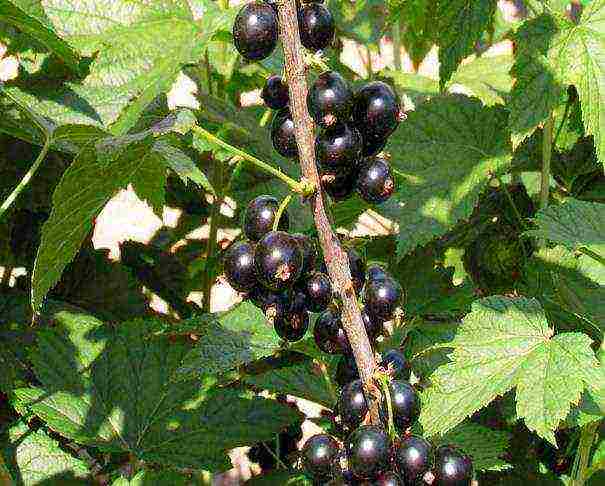
Variety universal purpose.
Bush vigorous, slightly spreading, medium branching.
Biological features: the variety is highly self-fertile. Self-pollination forms 60% of the ovary. Additional pollinators - Belorusskaya Sweet, Pavlinka, Pilot Alexander Mamkin.
Fruit brush long, medium-dense berries.
Berries large (average weight - 1.4 g)... The taste is sweet and sour, with aroma, pleasant, the pulp is very juicy. The tasting score is good.
Dignity: The variety is winter-hardy, productive (11 t / ha). It is slightly affected by spheroteca.Sprinkling of berries is absent. Suitable for mechanized harvesting. The transportability of fresh berries is high.
Flaw: Relatively resistant to kidney mites.
Claudia
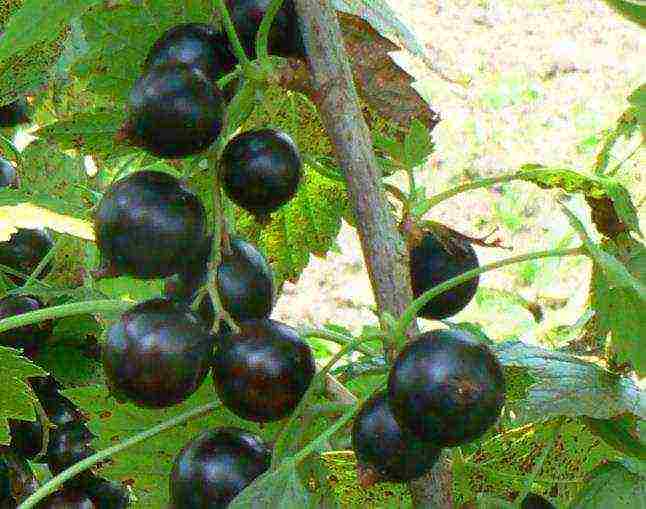
Variety universal purpose.
Bush medium-sized, straight, slightly spreading, medium branching.
Biological features: the variety is highly self-fertile.
Fruit brush long and medium.
Berries large (average weight - 1.3 g), round, black, with a dense skin. The appearance is attractive. Tasting assessment of fresh berries - 4.0 points. Medium density pulp, sweet-sour taste, pleasant.
Dignity: The variety is winter-hardy, high-yielding (up to 9.0 t / ha). Moderately affected by spherotek.
Flaw: Relatively resistant to leaf spots and kidney mites ..
KLUSSONOVSKAYA
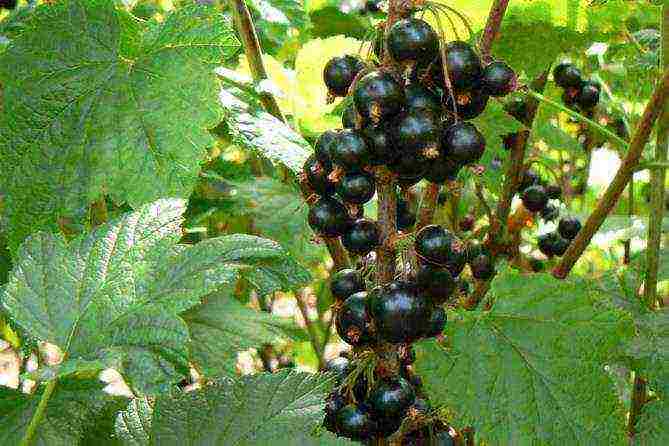
Variety universal purpose.
Bush vigorous, slightly spreading, medium branching.
Biological features: the variety is highly self-fertile. Additional pollinators - Belorusskaya Sweet, Minai Shmyrev, Pavlinka.
Fruit brush long on young branches, medium on old ones.
Berries large (average weight - 1.2 g). The tasting score is good. The taste is sweet and sour, pleasant.
Dignity: The variety is winter-hardy, high-yielding (12-13 t / ha). Sprinkling of berries is absent. The transportability of fresh berries is high. Suitable for mechanized harvesting.
Flaw: Relatively resistant to kidney mites.
BATH
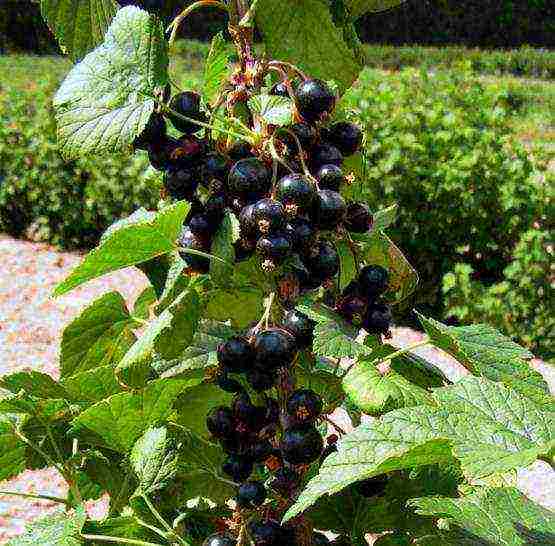
Variety universal purpose.
Bush medium-sized, slightly spreading, strong branching.
Biological features: the variety is highly self-fertile.
Fruit brush average.
Berries large (average weight - 1.4), round-oval, black, shiny, with a thin skin. The appearance is very attractive.
Dignity: The variety is highly winter-resistant, high-yielding (up to 18 t / ha). Sprinkling of berries is absent. The transportability of fresh berries is high.
Flaw: Relatively resistant to powdery mildew and kidney mite... Demanding growing conditions.
Nara
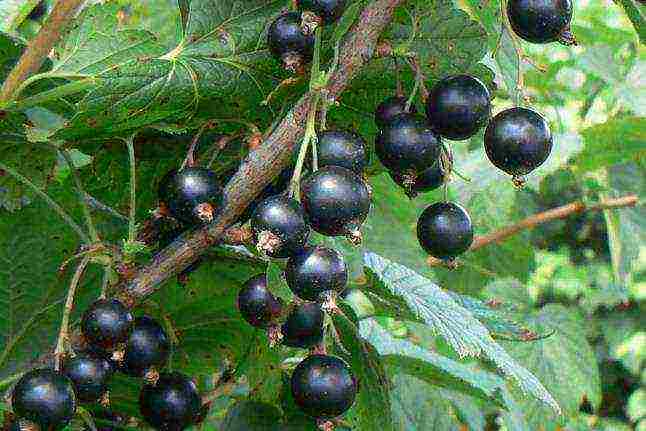
Variety universal purpose.
Bush medium-sized, semi-spreading, medium branching.
Biological features: the variety is highly self-fertile.
Fruit brush long and medium.
Berries large (average weight - 1.3 g), round, black, with a dense skin. The appearance is attractive. Tasting assessment of fresh berries - 4.0 points. Medium density pulp, sweet-sour taste, pleasant.
Dignity: The variety is winter-hardy, high-yielding (up to 9.0 t / ha).
Flaw: Relatively resistant to spheroteca, leaf spots and kidney mites.
Peacock
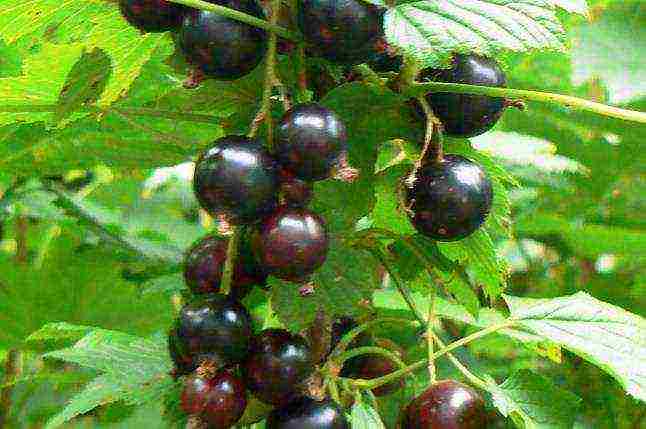
Variety universal purpose.
Bush medium-sized, semi-spreading, medium branching.
Biological features: the variety is self-fertile.
Fruit brush average.
Berries medium (average weight - 1.1 g), round, black, with a dense skin. The appearance is attractive. Tasting assessment of fresh berries - 4.0 points. Medium density pulp, sweet-sour taste, pleasant.
Dignity: The variety is winter-hardy, high-yielding (up to 8.0 t / ha).
Flaw: Relatively resistant to spheroteca, leaf spots and kidney mites.
IN MEMORY A.G. VOLUZNEVA
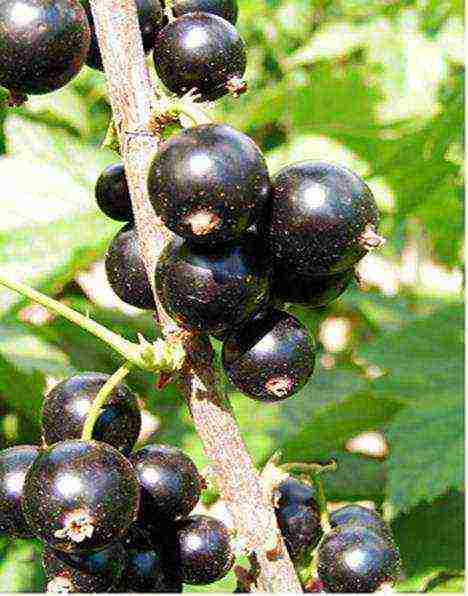
Variety dessert purpose.
Bush vigorous, medium spreading, compact, medium branching.
Biological features: the variety is highly self-fertile. Additional pollinator - Belarusian sweet.
Fruit brush medium and short.
Berries large (average weight - 1.5 g), attractive appearance. The tasting score is good. The taste is sweet, aromatic, pleasant.
Dignity: The variety is winter-hardy, high-yielding (14.1 t / ha). Highly resistant to anthracnose and spherotek. The transportability of fresh berries is high. Suitable for mechanized harvesting.
Flaw: Relatively resistant to kidney mites.
MEMORY OF VAVILOV
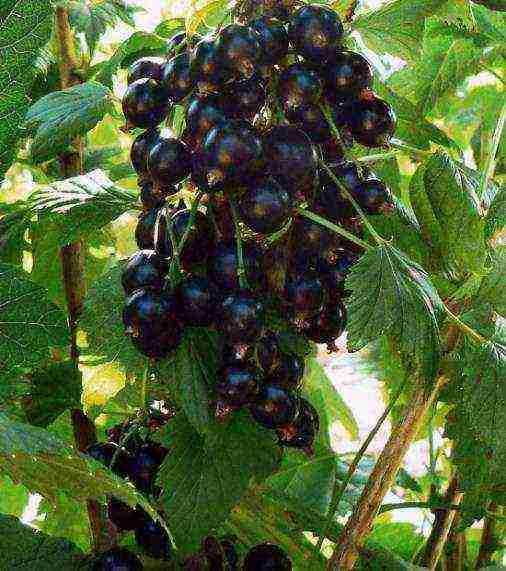
Variety universal purpose.
Bush vigorous, slightly spreading, medium branching.
Biological features: grade highly self-fertile... 60% of the ovary is formed by self-pollination. Additional pollinators - Pavlinka, Belorusskaya sweet.
Fruit brush medium and short.
Berries large (average weight - 1.2 g). The tasting score is good. The taste is sweet, with an average aroma, pleasant, characterized by an optimal ratio of sugar and acids.
Dignity: The variety is winter-hardy, high-yielding (12 t / ha). Highly resistant to anthracnose and spherotec. Sprinkling of berries is absent. The transportability of fresh berries is high. Suitable for mechanized harvesting.
Flaw: Relatively resistant to kidney mites.
SANUT

Variety universal purpose.
Bush tall, straight, slightly spreading, medium branching.
Biological features: the variety is highly self-fertile.
Fruit brush long and medium.
Berries large (average weight - 1.3 g), elongated-rounded, black, with a dense skin. The appearance is attractive. Tasting assessment of fresh berries - 4.0 points. Medium density pulp, sweet-sour taste, pleasant.
Dignity: The variety is winter-hardy, high-yielding (up to 11 t / ha). Moderately affected by spheroteca, weakly affected by leaf spots. Sprinkling of berries is absent. The transportability of fresh berries is high. Suitable for mechanized harvesting.
Flaw: Relatively resistant to kidney mites.
Suite Kiev
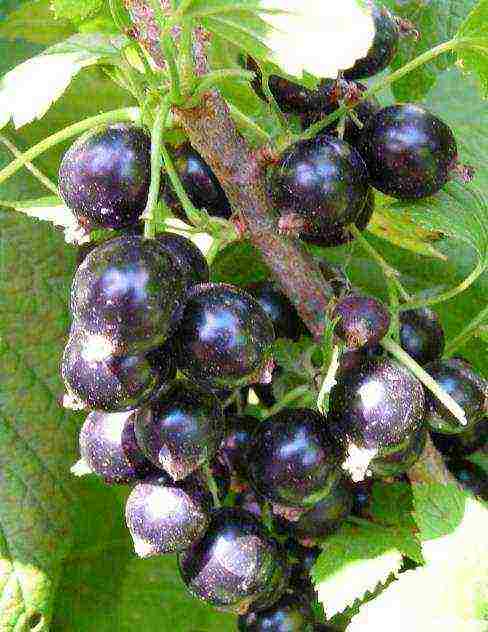
Variety universal purpose.
Bush tall, straight, slightly spreading, medium branching.
Biological features: the variety is highly self-fertile.
Fruit brush long and medium.
Berries large (average weight - 1.1 g), elongated-rounded, black, with a dense skin. The appearance is attractive. Tasting assessment of fresh berries - 4.0 points. Medium density pulp, sweet-sour taste, pleasant.
Dignity: The variety is winter-hardy, high-yielding (up to 11 t / ha). Moderately affected by leaf spots.
Flaw: Relatively resistant to spheroteca and kidney mites.
CERES
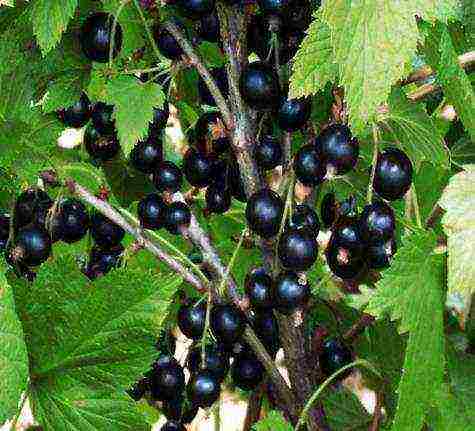
Variety universal purpose.
Bush medium-sized, slightly spreading, medium branching.
Biological features: the variety is highly self-fertile. An additional pollinator is Pavlinka.
Fruit brush medium and short.
Berries large (average weight - 1.2 g)... The tasting score is high. Medium density pulp, sweet-sour taste, pleasant.
Dignity: The variety is winter-hardy, high-yielding (12-13 t / ha). Highly resistant to spheroteca and anthracnose. Sprinkling of berries is absent. The transportability of fresh berries is high. Suitable for mechanized harvesting.
Flaw: Relatively resistant to kidney mites.
Clate ripening ororta
Lazy person
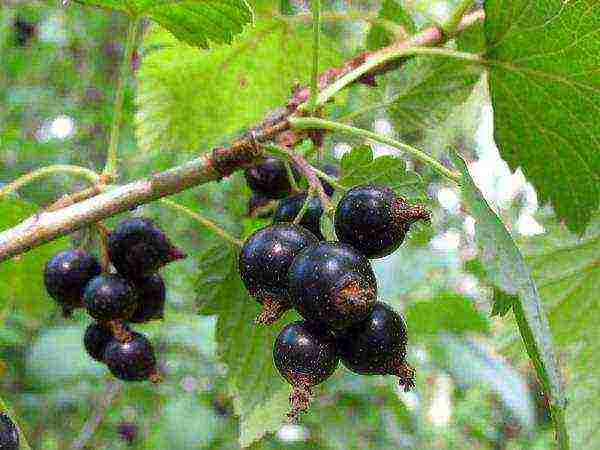
Variety universal purpose.
Bush medium-sized, erect, medium branching.
Biological features: the variety is highly self-fertile.
Fruit brush medium or long.
Berries medium (average weight - 1.3 g), round, black, matte, with a blue waxy coating. The appearance is attractive. Tasting assessment of fresh berries - 4.0 points. Medium density pulp, sweet and sour taste.
Dignity: The variety is winter-hardy, high-yielding (up to 11.0 t / ha).
Flaw: Strongly affected by spheroteca, relatively resistant to leaf spots and kidney mites.
TITANIUM
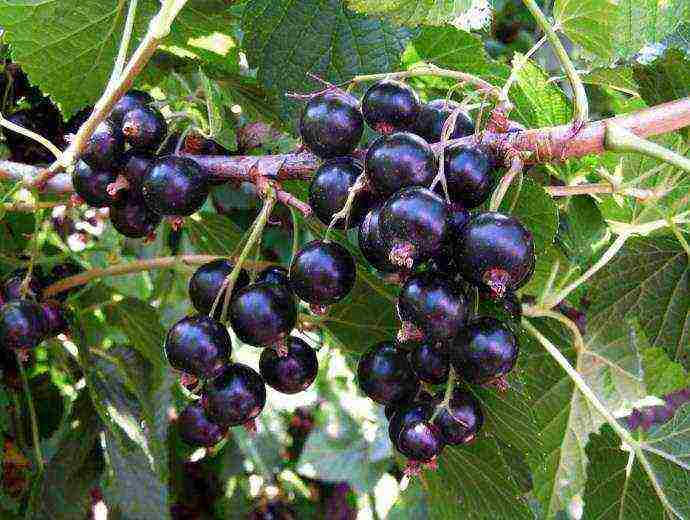
Variety universal purpose.
Bush tall, straight, slightly spreading, medium branching.
Biological features: the variety is highly self-fertile.
Fruit brush long and medium.
Berries large (average weight - 1.2 g)... The tasting score is high. Medium density pulp, sweet-sour taste, pleasant.
Dignity: The variety is winter-hardy, high-yielding (up to 7.5 t / ha). Highly resistant to spheroteca and weakly affected by leaf spots. Marketability and transportability of fresh berries is high. Suitable for mechanized harvesting.
Flaw: Relatively resistant to kidney mites.
Loading …
Loading …
View all polls
Material prepared by: gardening specialist Buinovsky O.I.
(Number of views - 1 702, today - 1)
It is difficult to choose the most suitable one for your site from more than two hundred varieties of black currant. There is the largest-fruited, fruitful, early, sweet - it is worth trying all the best that are bred by domestic and foreign breeders.
How to choose currants for planting on the site
When selecting a variety, consider the following:
- how drought tolerant it is;
- how it is adapted to frost and temperature extremes;
- flowering and harvesting period;
- is it picky about leaving;
- how strong the immunity to pests and diseases is.
Correlate the characteristics of the variety with the temperature regime of your region, soil fertility and other features of your area and site, and then evaluate it according to personal preferences:
- what kind of currant do you prefer to taste: sweeter or with a bright sourness;
- whether your crop will be transported. For this, it is important to know the thickness of the peel of the fruit and the dryness of separation.
The largest varieties
With the mass of one blackcurrant berry more than 1.5 g, the variety is classified as large-fruited. Among these varieties there are also frost-resistant ones, easily adapting to heat and low humidity.
Vigorous
Elite large-fruited variety of currant. The weight of the berries reaches 8 g. Harvest ripens at the end of July, about 6 kg are harvested from each bush. The pluses of the variety include:
- dense and firm pulp;
- self-pollination;
- resistant immunity to kidney mites.
Gardeners also note significant shortcomings of Yadrenaya:
- high requirements for care, systematic pruning;
- the need to renew the plant every 5–7 years;
- irregular berries on the brush;
- inability to transport fruits;
- sour taste of berries;
- susceptibility to powdery mildew.
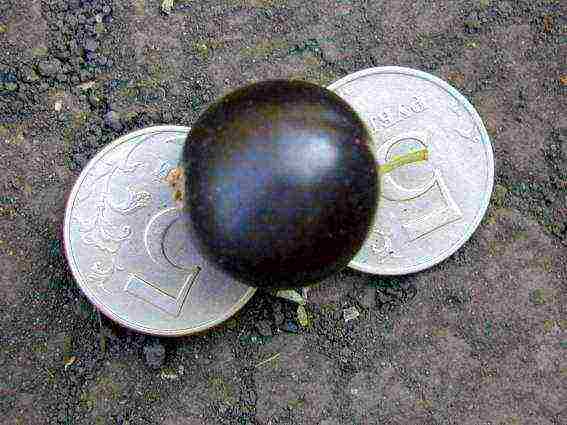
The Blackcurrant Variety Variety is popular due to the large size of the berries.
Dobrynya
The weight of the largest berries of the variety is 7 g. By mid-May, the currants bloom, harvesting begins after July 15. One bush can produce more than 2 kg of berries. The indisputable advantages of Dobrynya, in addition, include:
- dry separation of fruits, as well as their dense rind. These features are important for ease of transportation;
- pleasant aroma;
- sweet and sour aftertaste;
- plant immunity to powdery mildew.
Disadvantages of the variety:
- young cuttings do not take root well;
- pretentious to the care and fertility of the soil;
- affected by a kidney mite;
- fruits ripen at different times;
- berries on a cluster are heterogeneous in size and size.
Black currant Dobrynya - video
Selechenskaya-2
This is an early currant with a fruit weight of about 6 g. Gives a good harvest, amounting to about 4 kg of sweet berries with a slightly sour taste. Moreover, they can easily carry transportation. The bush practically does not get sick with powdery mildew.
Selechenskaya-2 - one of the best varieties of currant - video
Black Pearl
The berry weight is close to 5 g. The yield is sufficient: one plant brings an average of 4 kg.
Other valuable qualities of the variety:
- fruits are easily transported. This is facilitated by the dry separation of the berries;
- harvesting can be mechanized;
- undemanding to agricultural technology;
- resistant to diseases such as anthracnose and kidney mites.
Cons of Black Pearl:
- phased harvesting due to non-simultaneous maturation of the brush;
- soft currant aroma;
- sour aftertaste.
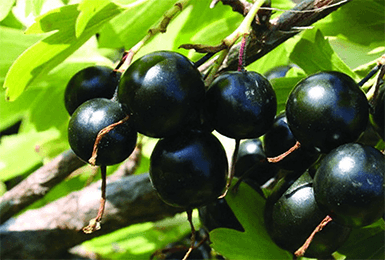
Currant berries of the Black Pearl variety have a rounded shape and weight up to 5 g
A distinctive quality of the variety is the increased content of pectins in berries. This is true for those who actively use currants for jams and jellies.
The sweetest black currant
Currants are considered the sweetest, in which the greatest amount of useful sugars and the least - acids. Such varieties have a pleasant taste with a slight sourness, as well as high winter hardiness.
Green haze
Variety characteristics:
- average ripening period;
- the berry weighs about 1.5 g;
- yield about 4 kg;
- undemanding care.
The main drawback of currants is susceptibility to such a pest as a kidney mite.
The Green Smoke variety has one of the highest rates of sugar content in fruits (12.2%).
Bagheera
A variety of medium ripening, high yield. The berry weighs about 1.5 g, it contains 10.8% sugar. Bagira has many advantages:
- resistance to heat and drought;
- self-pollination;
- the same fruit size;
- friendly ripening of berries;
- suitability for transportation.
The main disadvantage of the variety is its weak resistance to currant diseases.
The variety is especially popular among those who are fond of herbal medicine, because the foliage of the plant is preserved almost until frost.
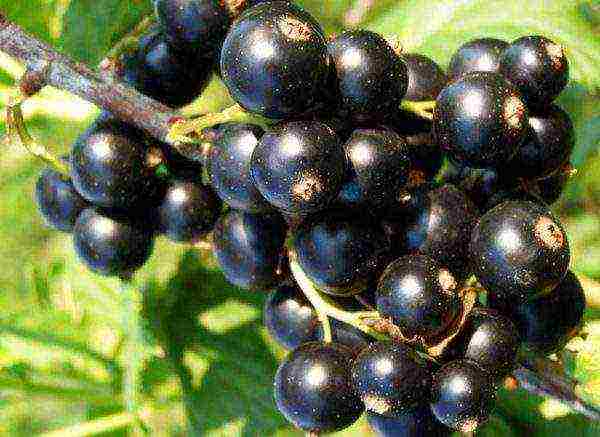
Ripening of Bagheera currant berries occurs simultaneously
Pygmy
Characteristic features of the variety:
- large-fruited currants with a berry weight of up to 5 g and a high yield annually;
- berries have a pronounced currant aroma;
- self-fertility;
- the fruit has a thin peel, so the portability is low;
- not susceptible to powdery mildew and anthracnose, but affected by kidney mites.
The sweetest black currant - video
In the Netherlands, a dwarf blackcurrant variety Ben Sarek was bred with a bush height of no more than 90 cm (with an average currant height of 1.2–2 m). The plant is adapted to a cool climate, has large berries with a winey, sweet taste, gives a stable, evenly ripening crop.
Earliest and latest varieties
The early varieties are those that you start harvesting in June.
Summer resident: early currant
This variety is distinguished by:
- stable yield. The bush is self-pollinated, therefore it is less dependent on weather conditions and insects;
- sweet taste. The variety will be appreciated by lovers of currants, since the characteristic sour aftertaste is practically not present in the berries of the Dachnitsa;
- short stature. With a high yield, the lower branches will lie on the ground;
- resistance to winter cold. The plant tolerates a drop in temperature to -32 ° C well, but if flowering occurs in spring frosts, the bush requires protection (smoke or shelter).
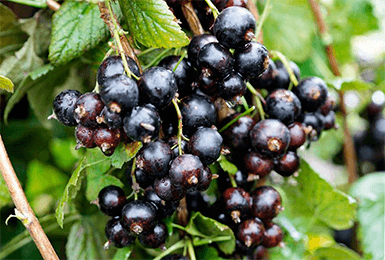
Currant berries of an early variety Dachnitsa will be especially appreciated by lovers of sweets, since they practically do not have sourness
Exotic: early variety
Pros of the variety:
- large-fruited;
- good winter hardiness;
- sufficient yield (up to 3 kg per bush);
- the comfort of picking berries due to the presence of a straight thick brush axis, reminiscent of a grape;
- immunity to powdery mildew.
Cons of Exotic:
- the plant does not tolerate drought well, therefore, in the heat, systematic watering is required;
- in conditions of high humidity, the berries are prone to decay;
- the peel of the fruit is thin, so they will not tolerate long-term transportation;
- low immunity to fungal diseases (except for powdery mildew).
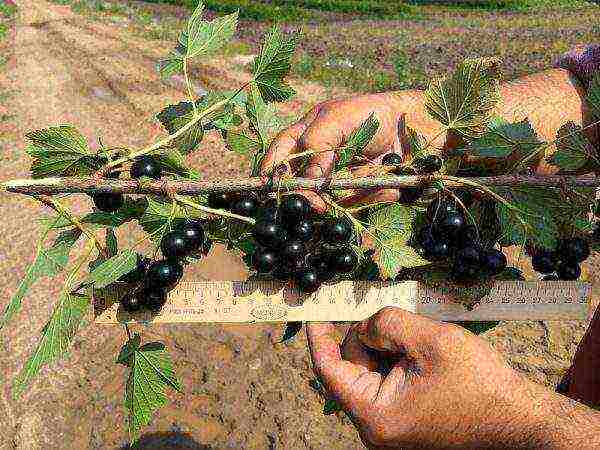
The bush currants of the early Exotica variety have a straight, thick bristle axis, which greatly facilitates harvesting.
Ultra early variety Sorceress - video
Bummer: late currant
The name Lazyboy was given due to the fact that it ripens in August, when the currants of other varieties have already been harvested.
Variety characteristics:
- large-fruited, but the yield is low (about 1 kg);
- dessert-flavored berries with a sweet aftertaste and pronounced aroma;
- the fruits do not tolerate transportation well due to the thin peel and pulp of medium density.
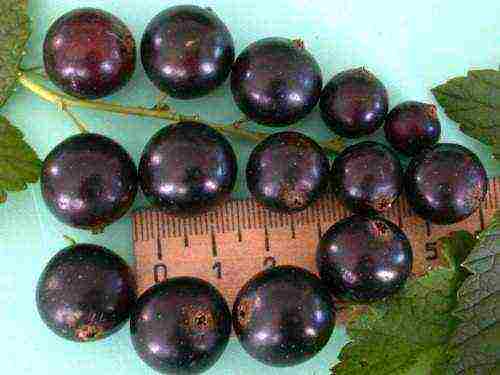
Fruiting of currants of the Lazytay variety occurs in late July-early August
New varieties of black currant
Recently, several new varieties of black currant have been included in the State Register of the Russian Federation:
- Agatha,
- Sadko,
- Iskitim gift,
- In memory of Kuminova.
Their main advantage is their high immunity to diseases and pests. The new varieties are well adapted to low temperatures and drought.
Varieties recently included in the State Register - photo gallery
What currants can be grown in the regions
When choosing a variety, it is important to take into account the advice of experts on the zoning of currants. After all, each region is characterized by its own climatic conditions, temperature regime, soil, prevalence of diseases and pests.
Black currant for cultivation in the Moscow region
The State Register of Breeding Achievements for this region has recommended more than thirty varieties of black currant, among them:
- Dobrynya,
- Lazy person,
- Selechenskaya-2,
- Exotic,
- Green haze
- Moscow,
- Litvinovskaya.
Moscow
An early ripening currant with a high yield and a pleasant - with a sweet and sour note - the taste of berries. The variety is distinguished by a rather long (up to 10 cm) brush, convenient for harvesting.

The currant variety Moscow berries of universal purpose with a sweet-sour taste
Litvinovskaya
Medium early, not afraid of recurrent frost currant. Other positive features of the variety:
- large-fruited;
- sweet taste and refreshing aroma of fruits;
- strong immunity to fungal diseases.
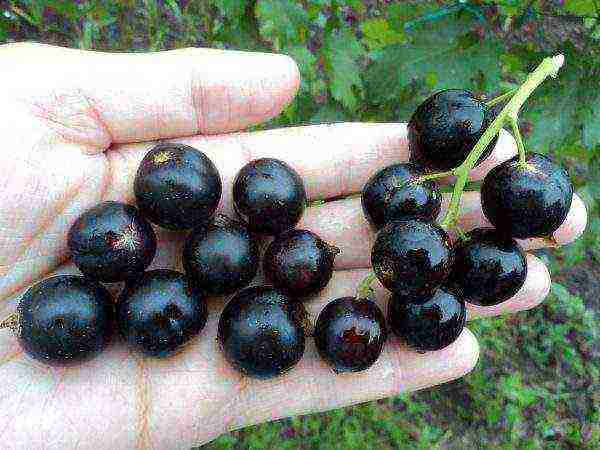
Litvinovskaya currant berries reach a weight of 4 g
Varieties suitable for the Northwest region
The proven varieties for growing in the Northwest region with its high humidity are:
- Bagheera,
- Selechenskaya-2,
- Lazy person,
- Green haze
- Summer resident.
Among the promising varieties can be called Nina. It is an early ripening currant with large fruits and a high sugar content in the berries. The variety is high-yielding and self-fertile.
Black currant for cultivation in the Black Earth region
Recommended for this region are varieties of increased drought resistance:
- Black Pearl,
- Selechenskaya-2,
- Green haze.
Belorusskaya sweet can be promising for regionalization.
Belarusian sweet
Bred by Belarusian breeders. This is a medium-ripening, high-yielding variety. Its distinctive characteristics:
- high self-fertility;
- increased content of pectin substances;
- berries almost do not crumble.
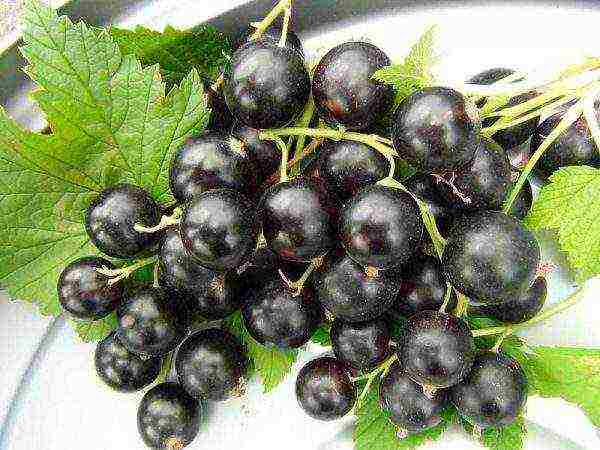
The variety Belorusskaya sweet is quite resistant to powdery mildew and anthracnose.
Currant varieties for Siberia
The climatic features of Siberia require the selection of specially zoned black currant varieties, although the following are suitable:
- Vigorous,
- Bagheera,
- Pygmy,
- Selechenskaya-2,
- Black Pearl,
- Dobrynya,
- Green haze.
New varieties are specially adapted to the conditions of the region, such as:
- Agatha,
- Iskitim gift,
- In memory of Kuminova.
Black currant for growing in Belarus
For cultivation in Belarus, the following varieties of black currant are recommended:
- Enchantress,
- Belarusian sweet,
- Lazy person.
The varieties that are promising for cultivation in the republic include:
- Belorusochka,
- Memory of Vavilov,
- Ceres.
All of them are characterized by frost resistance and sufficient yield.
Varieties for cultivation in Ukraine
Here, in recent years, conditions unfavorable for currants have been noted. High spring temperatures lead to rapid evaporation of moisture from the soil. In summer, the weather is hot and dry. Currant varieties for growing in Ukraine should be chosen according to the degree of adaptation, primarily to drought and high temperatures.
Suitable for cultivation in all regions of Ukraine varieties:
- Pygmy,
- Lazy person,
- Nuclear.
Among the promising ones are the Jubilee Digging and the Beauty of Lviv.
Jubilee Digging
A mid-ripening variety bred by the Institute of Horticulture of the NAAS with a high yield annually. Sweet and sour taste, large and one-dimensional berries, as well as resistance to changes in climatic conditions, diseases and pests make the variety especially popular among Ukrainian gardeners.
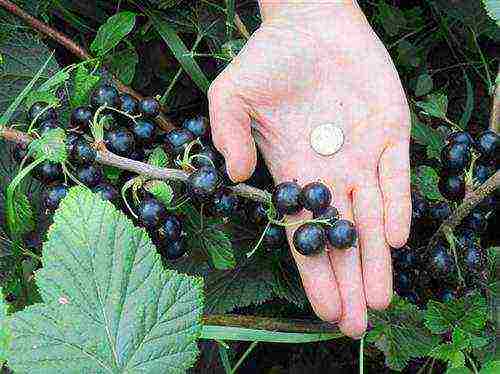
The fruits of the currant variety Yubileynaya Kopanya are large, one-dimensional, ripen together
I would call Jubilee Digging an excellent variety on a 5-point scale. Among the late ripening Ukrainian varieties on my site, only Krasa Lvova is better.
Beauty of Lviv
The variety is of local selection, therefore, it is well adapted to the climatic features of Ukraine.This large-fruited currant with a dessert flavor and a high yield has a strong immunity to major diseases and pests.

Berries of currant varieties Krasa Lvova grow shiny, black, medium-sized, with a strong elastic skin
To achieve the maximum effect in growing black currants, do not stop at one variety, experiment. Plant plants with different fruiting times. This will prolong the presence of fresh berries in your diet, understand your taste priorities and pinpoint the most promising variety for your site.
Rate the article:
(1 vote, average: 1 out of 5)
Currently, 9 varieties of black currants (Katyusha, Memory of Vavilov, Ceres, Klussonovskaya, Heiress, Titania, Almyai, Gagatai, Kryvyai). This article also contains photo of black currant varieties.
Black currant variety Katyusha
Variety of selection RUE "Institute of Fruit Growing" (Belarus). The variety is of medium ripening, winter-hardy, highly self-fertile, high-yielding (11 t / ha). The bush is vigorous, slightly spreading, medium branching. Sprinkling of berries is absent. Moderately affected by American powdery mildew, relatively resistant to kidney mites. The berries are black, shiny, oblong-oval, with a very dense skin, the average weight of the berry is 1.4 g, sweet and sour, with aroma. The transportability of the berries is high. A universal variety, suitable for growing in all regions of Belarus.
Black currant variety Pamyat Vavilov
Variety of selection RUE "Institute of Fruit Growing" (Belarus). The variety is of medium ripening, winter-hardy, highly self-similar, high-yielding (12 t / ha). The bush is vigorous, slightly spreading, medium branching. Sprinkling of berries is absent. It is moderately affected by anthracnose and American powdery mildew, relatively resistant to kidney mites. Berries are black, average weight 1.2 g, round, shiny, medium-dense skin, sweet. The transportability of fresh berries is high. A multipurpose variety, suitable for cultivation in all regions of Belarus.
Black currant variety Klussonovskaya
Variety of selection RUE "Institute of Fruit Growing" (Belarus). The variety is of medium ripening, winter-hardy, highly self-fertile, high-yielding (12-13 t / ha). The bush is vigorous, slightly spreading, medium branching. Sprinkling of berries is absent. Moderately affected by American powdery mildew, relatively resistant to kidney mites. Berries are black, round, average weight 1.2 g, thin skin, sweet and sour. The transportability of fresh berries is good. A multipurpose variety, suitable for cultivation in all regions of Belarus.
Belarusian black currant variety Ceres
Variety of selection RUE "Institute of Fruit Growing" (Belarus). The variety is of medium ripening, winter-hardy, highly self-fertile, high-yielding (12-13 t / ha). The bush is medium-sized, slightly spreading, medium branching. Sprinkling of berries is absent. It is slightly affected by American powdery mildew and anthracnose, relatively resistant to kidney mites. The berries are black, round, with an average weight of 1.2 g, with a skin of medium density, sweet and sour. Marketability and transportability of fresh berries is high. A multipurpose variety, recommended for cultivation in the Mogilev region.
Russian variety of black currant Heiress
The variety was bred at the All-Russian Institute of Selection and Technology of Horticulture and Nursery (Russia). A variety of early ripening, winter-hardy, highly self-fertile, productive (8-9 t / ha), relatively resistant to fungal diseases and pests.
The bush is medium-sized, slightly spreading.The berries are medium, black, rounded, the average weight of the berry is 1.3 g, the taste is sweet and sour. The transportability of fresh berries is good. A multipurpose variety, suitable for cultivation in all regions of Belarus.
Blackcurrant variety Titania
The variety was bred in Sweden. The variety is late ripening, winter-hardy, highly self-fertile, productive (10-12 t / ha), relatively resistant to diseases and pests. The bush is vigorous, slightly spreading. Berries are black, shiny, round, with thick skin, average weight 1.2 g, sweet and sour. The transportability of the berries is high. A universal variety, suitable for growing in all regions of Belarus.
Black currant variety Belorusochka
The variety is bred in RUE "Institute of Fruit Growing" (Belarus). The variety is of medium ripening, winter-hardy, highly self-fertile, high-yielding 13-14 t / ha, resistant to spheroteca and anthracnose, relatively resistant to kidney mites. The bush is vigorous, slightly spreading, medium branching. Sprinkling of berries is absent. Berries are black, shiny, rounded with a dense skin, average weight 1.4 g, sweet and sour. The transportability of the berries is high. A multipurpose variety, suitable for cultivation in all regions of Belarus. The state test is underway. In 2009, the State Register of Varieties and Trees and Shrubs of the Republic of Belarus included black currant varieties Almai, Gagatai and Kriviai, bred by the Lithuanian Institute of Horticulture and Vegetable Growing. The varieties are recommended for cultivation in the Vitebsk region.
Ukrainian variety of black currant Sanyuta
The variety was bred at the Institute of Horticulture UAAS. The variety is of medium ripening, winter-hardy, self-fertile, high-yielding (11 t / ha), weakly affected by American powdery mildew and moderately by anthracnose. The bush is medium-sized, compact. Sprinkling of berries is absent. Berries are round-conical, black, shiny, average weight 1.3 g, with a thick skin, dry separation, sweet and sour taste, with a moderate aroma. The transportability of the berries is high. A multipurpose variety, allocated for transfer to the state test system.
We do not disdain picking berries from wild plants, but we especially honor the varietal berries.
Breeding region and breeding history
The natural habitat of black currant is all continents of the Northern Hemisphere. Somewhere currant represented by only one species, as in Europe, and somewhere else by all the other 149 varieties. Siberia, the Far East and North America are especially rich in a variety of wild berries.
The main task a person who had been engaged in the cultivation of black currants since the 16th century was to obtain larger fruits than in nature and impart vital resistance to diseases and pests to new hybrids.
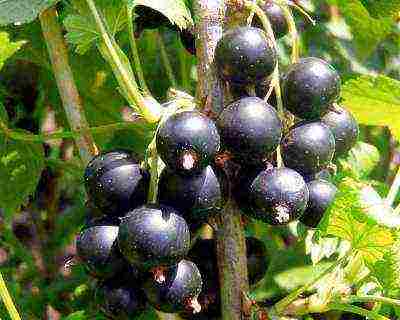 Therefore, savage plants to this day are actively involved in the process of crossing, endowing such varieties as “Belorusskaya Sweet” with unique qualities.
Therefore, savage plants to this day are actively involved in the process of crossing, endowing such varieties as “Belorusskaya Sweet” with unique qualities.
In creating this variety, breeders of the NIIKiP of Belarus used a complex method of interspecific crossing.
Hybrid forms 2-4D or 2-6D were taken as a basis, the genealogy of which was influenced by the heredity of popular European species and selected subspecies from Siberia and the Far East.
For 10 years, the hybrid has been undergoing varietal tests in order to get into the State Register in 1979 as recommended for cultivation in 10 regions of the Russian Federation.
Nowadays, a well-established, reliable variety "Belarusian Sweet" - an indispensable garden plant in industrial farms and private estates in 45 regions of Russia. It is recognized as the leading variety of this species for the Non-Chernozem zone.
However, such varieties as Bagira, Gulliver, Venus, Dachnitsa, Valovaya and Dobrynya are quite often found in the gardens of this region.
20 berries black currant in the daily diet - daily rate of our body in ascorbic acid.
Photo
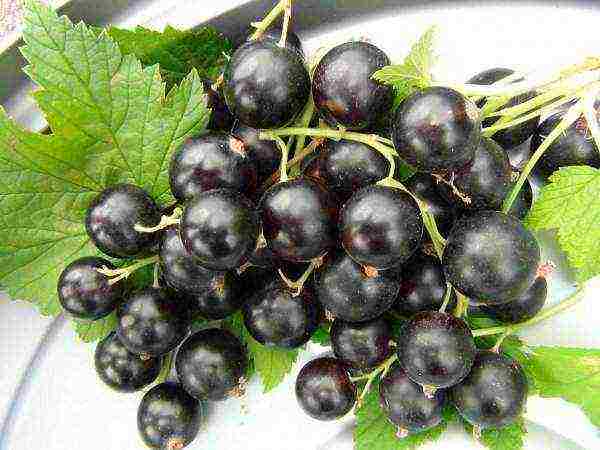
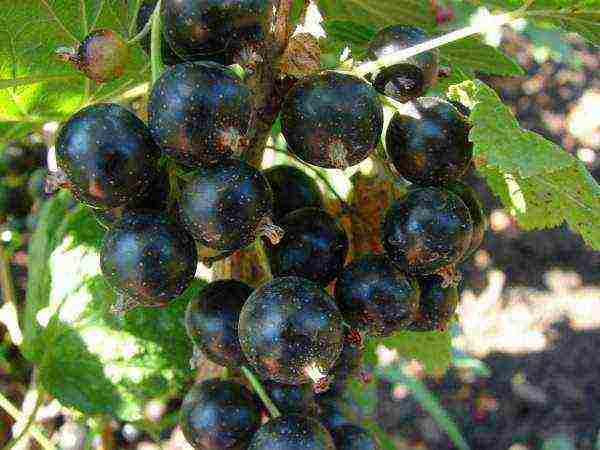
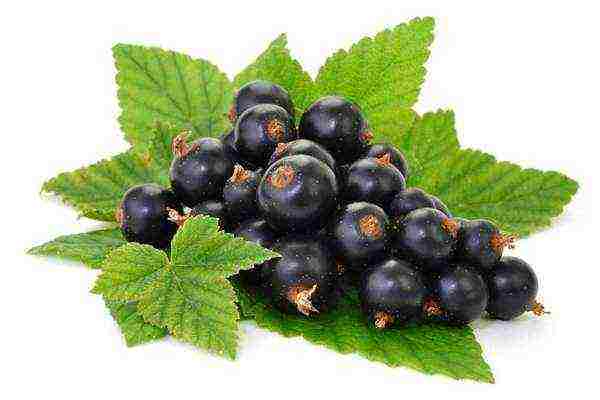
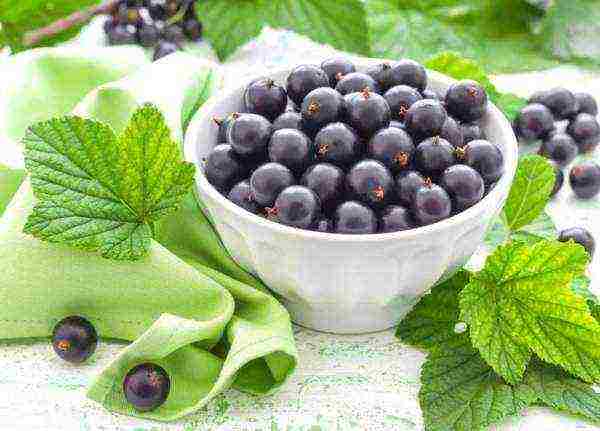
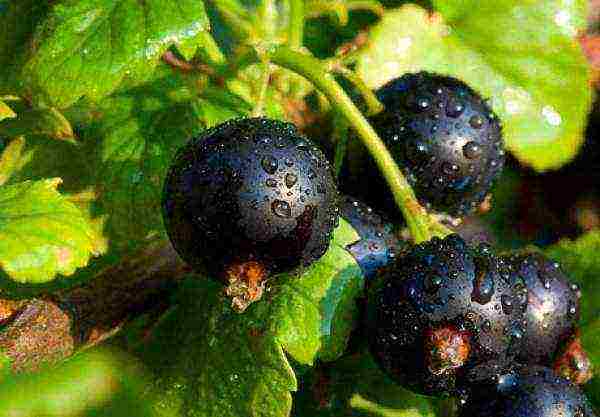
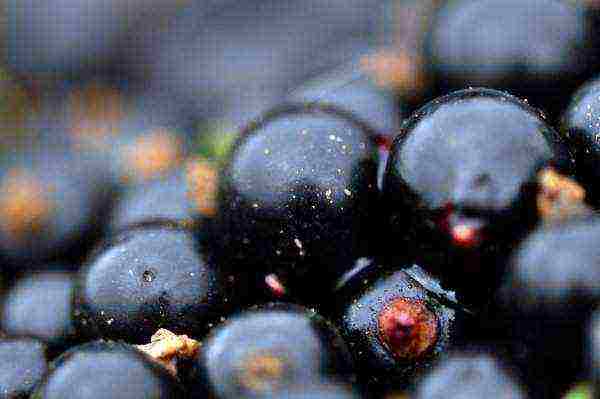
Description of the variety of currants "Belarusian Sweet"
Black currant "Belarusian sweet" description. This is a direct relative of the gooseberry, deciduous, bushy plant. In nature, it prefers mixed forests, river valleys and ravine slopes. Grows alone or in communities.
Actually, these same habits are characteristic of the variety "Belarusian Sweet":
- loves light, but does not shy away from partial shade;
- prefers fertile, drained soils, but grows well on loams;
- is afraid of temperature changes in the flowering phase and does not tolerate waterlogging.
In the shade, the plant may cease to bear fruit, and in the vicinity of the sedge it will pick up goblet rust.
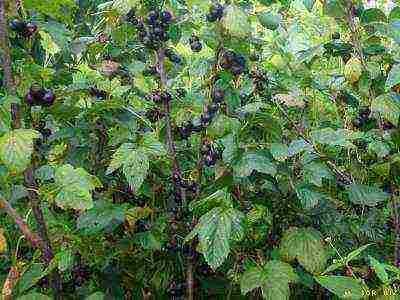 Bush in height they are classified as vigorous (up to 1.2 m), according to the spread of shoots - medium spreading (up to 1, 2 m).
Bush in height they are classified as vigorous (up to 1.2 m), according to the spread of shoots - medium spreading (up to 1, 2 m).
It has a rounded shape, forming a powerful bushy structure with straight shoots.
Every year it grows from the base with new basal shoots, which after a year already begin to branch, and after 3 years - bear fruit.
They form the skeleton of a bush, which after 8 years loses its former productivity. Woody shoots are cut out over time, and the old plant, which has reached 15 years old, is replaced with a new one.
- Root system located superficially in a 30-centimeter layer of soil, but an adult plant can give powerful roots in depth (up to 2 m). Therefore, it is important to take into account the depth of the groundwater when planting.
- Currant shoots are presented in 4 types (mixed, fruit, bouquet, kolchatka). They also differ in color: some of them are anthocyanic in color - in the range of saturated red - violet, which depends on the acidic environment.
Medium in thickness - gray, slightly pubescent. Each new shoot has 3 growth zones and only 2 (upper) fruiting zones.
- Kidney in terms of functionality, they are represented: sleeping, growth and flowering. In different parts of the shoot, the buds differ in color, size and shape. Growth buds give growth to basal shoots, flowering buds - to fruits. Sleepers - waiting in the wings, in case of extreme conditions for the plant.
- Leaves - light green (towards the ends of the branches they are smaller and lighter) have a 3-lobed structure with a powerful middle lobe. The surface of the leaf plate is matte, wrinkled, the edge is wavy with denticles. The petiole is red-purple, long.
- Flowers - self-fertile, which depends on the ratio of the size of the stamens and the column. The color is faded yellowish-green, the flowers are small bell-shaped, with 5 oval petals, collected in a brush, on which there can be opened flowers and buds at the same time. Flowering does not take place simultaneously, but sequentially: from the base to the end of the brush.
- Brushformed in the process of flowering, in the period when the ovary appears, acquires a size of up to 7 cm (for 3-6 berries). Ripening of berries occurs in the same way as flowering, sequentially. Clusters are loose, drooping, sometimes unite in clusters.
- Berry - rounded, fragrant, not calibrated, at various stages of growth changes color from green to brown and dark purple; the skin is shiny, dense contains dyes - from the group of flavanoids; in each berry weighing 1.6 grams. up to 37 seeds.
The high content of vitamin "C" gives the fruit a rich sweet and sour taste. Overripening of fruits leads to their shedding.
- Variety yield - up to 5 kg per bush or 12t / ha (in industrial production). Productivity tends to increase within 4-5 years, followed by stabilization (up to 12 years).
The highest productivity of the bush is noted at 6-8 years of age. Even unfavorable conditions during the flowering phase do not affect the yield.
As it was said, this currant tastes good, which makes it possible to cook good jam from it, for example, in combination with summer varieties of apples: Yellow Sugar, Korobovka, Krasnaya Gorka, Papirovka, Dachny.
The non-simultaneous ripening of berries in the brush leads to a variety of fruits, which affects the presentation. The variety is weakly vulnerable to spore lesions.
The main dignity Belarusian black currant varieties:
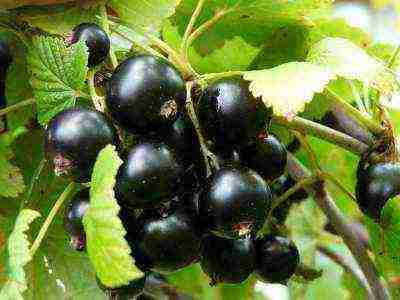 early entry into the fruiting period (in the 2nd year of the seedling's life);
early entry into the fruiting period (in the 2nd year of the seedling's life);- self-pollination ability with efficiency up to 72%;
- abundant annual fruiting;
- early ripening (by mid-July);
- excellent consumer quality of berries;
- versatility of application;
- winter hardiness;
- resistance to bacterial diseases and tick damage;
- successful propagation by cuttings.
To increase the yield and obtain large berries, the effect of cross-pollination is used, for which black currants are planted in groups of different varietal forms.
Application of berries
Since “Belorusskaya Sweet” is a universal variety, it may well be applicable as follows:
- for therapeutic purposes - in multivitamin preparations (berries, buds, leaves) and anti-inflammatory ointments based on gamma-linolenic acid contained in seeds;
- for decorative purposes, as an element of landscape design;
- as a productive honey plant (30kg / ha);
- as a flavoring agent (teas, kvass, sauces) and a spice for pickling;
- as an ingredient in dietary food (sugar-lowering salads);
- as a raw material for the production of drinks and confectionery: juices, compotes, syrups, jelly, tinctures, wines, liqueurs, yogruts, preserves, jams, jellies, marshmallows, fillings for pies and sweets;
- as a product of instant freezing while preserving the taste of live berries.
Black currant fully retains all its useful properties, not only during the freezing process, but also with any type of processing for homemade preparations.
It goes well with red currants, for example, with varieties: Andreichenko, Natalie, Marmeladnitsa, Beloved.
Care
What you need to know to "Belarusian Sweet" grew and bears fruit in your garden.
- Choosing the right location:
- closed from strong winds;
- with sufficient lighting;
- protected from spring waterlogging during snow melting;
- remote from groundwater;
- with soil acidity not higher than pH7.
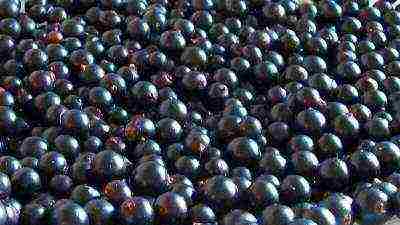 Plant until mid-October, avoiding subsequent transplants.
Plant until mid-October, avoiding subsequent transplants.- Creation of conditions in collective plantings for direct (within the variety) and cross (with other varieties) pollination. In this case, the distance between the bushes should remain at least 1.5 meters.
- For the constant renewal of the bush due to the basal shoots, it is initially planted in the ground at an angle of 45 ° so that the growth buds have a place to turn around.
- With the help of spring sanitary pruning, you can significantly help the plant recover after winter, leaving 10-12 shoots of different ages.
- Regular watering - 10 liters per bush.
- Loosening should precede watering.
- For currants, weeding is also relevant.
- 2 times per season, it is advisable to spray the currants with a solution of copper sulfate.
- When preparing the bush for winter, you need to remove all dry leaves and pull off the bush in the root part with a strong cord.
In the most severe frosts, in the middle of winter, it is recommended water the plant and the ground underneath with steep boiling water. Such stress therapy will increase the fullness of the brush and the size of the berries.
As for diseases, we recommend that you familiarize yourself with the most common diseases of horticultural crops about which detailed articles have been written on our website: anthracnose, chlorosis, bacteriosis, powdery mildew and mildew, as well as scab, rust, fire blight and bacterial cancer, rubella.
Black currant variety "Belarusian Sweet" - a treasure trove of health and benefits in one plant. Plant in rows - you will win in the harvest.
